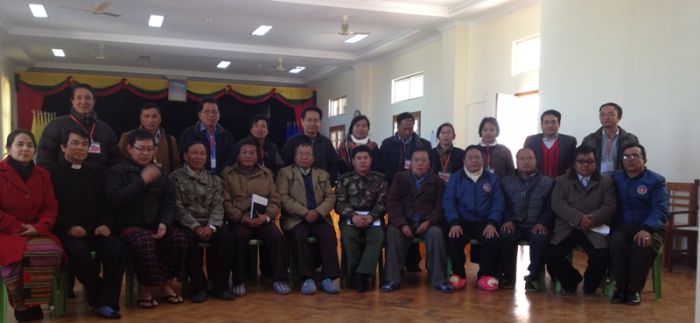Interview with Chin Committee for Emergency Response and Rehabilitation

Interview with Chin Committee for Emergency Response and Rehabilitation
26 January 2016 — A team of the Chin Committee for Emergency Response and Rehabilitation visited Chin State last week, meeting with the State government and UN/INGO agencies.
The civil society organization formed in the aftermath of last year’s flooding and landslides raised the voices of the affected Chin communities in Chin and Arakan (Rakhine) States, and Sagaing and Magwe Regions.
In this Chinland Guardian interview, Flora Bawi Nei Mawi, a CCERR team member, talked about their meetings, the current humanitarian situation and more.
Chinland Guardian: Who did you meet with from the Chin State government?
Flora Bawi Nei Mawi: All the nine State ministers and other Chin State government officials including the head of the Hakha District Administration Department.
Chinland Guardian: What was the purpose of the meeting with the government?
Flora Bawi Nei Mawi: Finding options and schemes to practically cooperate with the State government for a better response and resilience to flood and landslide disasters in Chin State.
Chinland Guardian: How were their responses?
Flora Bawi Nei Mawi: Their response could be observed in two ways: one is their response in the past and another is for the future. We observe there were many gaps in the past in terms of resources and cooperation with civil society organizations like us. They did not pay much attention to working with us. At this point, I mean at all levels – State, District and Township.
But at grass-roots level, the CCERR cooperated with se ein hmu (ten-household administrator) regarding data collection and sharing. The ministers are not aware of this sort of cooperation. In fact, the CCERR is advocating different agencies such as donors, UN, INGOs and Chin communities inside and outside of the country closing the gap when providing humanitarian assistance and aid.
For the second part, as I mentioned earlier, in terms of future collaboration and cooperation, the response is satisfactory and constructive. They opened the door and welcomed us to cooperate with them. We really hope that this is not just a show-off of the outgoing government but it should be a pragmatic approach to effective cooperation for the people. As their government term is finishing soon, we really hope that the next government also follows up our memorandum with the current one.
Chinland Guardian: There was a mass demonstration by the landslide-affected people in Hakha. What was the issue? And what has the State government done to address the problems?
Flora Bawi Nei Mawi: There are so many critical points from both sides – the State government and the Hakha Rescue Committee. If the State government has had independence in terms of authority from the Union government, they could have been able to solve this problem. Till today, they are receiving from the Union level instructions and directions, which are then handled by each line of the concerned ministries. The system is very complicated to follow practically.
Furthermore, the relocation management team of the State government did not exercise/use the most updated data and not attempt to work with the HRC. For the HRC, this is their first experience and their day to day management is such a challenge. It created more unintended consequences. Owing to not updating and following the most recent data and information, and mostly ignoring data provided by local communities such as the HRC, the State government has faced a bundle of problems, with some resulting in unjust allocation of resources, humanitarian support and aid delivery. As the State government has very limited budget to address the problems, they should collaborate with local actors such as the HRC in determining the victims affected by flooding and landslides. Local actors has social capacity to classify and identify different victims – whose houses are destroyed or damaged, and who are just waiting for the opportunity to get new houses and plots of land although their houses were not destroyed. Now, there are clashes between decision makers in the government and staff members who are working on landslide-related data. One staff member from the administrative sector said: “We are always lying about the data by either erasing or adding numbers in the list.”
Chinland Guardian: How was the meeting with the UN agencies and INGOs?
Flora Bawi Nei Mawi: These UN and INGOs agencies really paid attention to this issue. They told us they are also facing challenges, including that fact that Chin State is not attractive and interesting for donors. When compared with Kachin and Rakhine, Chin State seems less problematic. But looking at the indicators of livelihood destroyed, examining the quality of education and economical aspects, Chin State is at tremendous risk. The underlying issue is that international media do not touch the reality in Chin State. Some local media stated about this but international donors are not their audience. The very important feedback from UNICEF is that Chin State is still in “continuous emergency state” that needs to be kept in an exceptional case. It is in direct contradiction to the Union government’s declaration which states that the early recovery phase is finished in Myanmar.
Chinland Guardian: How did you find the humanitarian situation in Hakha?
Flora Bawi Nei Mawi: Local actors, especially displaced persons in the camps, are immensely thankful to donors for humanitarian aid delivered to them regardless of religion, ethnicity and geographical boundaries. It is such a beauty that Buddhist monks donate fund for the reconstruction of churches and crosses destroyed. Thanks to INGOs and UN agencies for their hard work within their limited funds. Of course, more substantial humanitarian assistance is needed as, I said, the situation in Chin State is an exception in comparison with other affected areas in Myanmar.
Chinland Guardian: Was it the first time CCERR travelled to Chin State after the landslides in August last year? Where else did you go?
Flora Bawi Nei Mawi: It is the first time the whole CCERR team has travelled to Hakha, the capital of Chin State. What I mean is, for example, Kanpetlet members did not have a chance to visit Hakha for this landslide particular issue. In fact, all of the nine representatives of the CCERR are from Chin State. In addition, Chin diasporas communities are also part of the CCERR and some, for instance, Chin community in Australia, sent their representatives to travel to different parts of Chin State and beyond, making donations and delivering humanitarian assistance to the affected people.
Chinland Guardian: What actually is the role of the CCERR in response to the natural disaster that had affected Chin communities in Chin State, Arakan (Rakhine) State, Sagaing Region and Magwe Region?
Flora Bawi Nei Mawi: In response to the disaster, various relief committees have been formed at local levels in various townships across the States and Regions. To supplement this effort, Chin political parties, Chin National Front – that signed a ceasefire agreement with the government, religious organizations, Chin civil society organizations, and other local actors came together and formed the Chin Committee for Emergency Response and Rehabilitation (CCERR) in August 2015.
First and foremost, the CCERR seeks to bring the voices of local people to the higher level where decisions about the nature and level of aid are made by the government, donors and INGOs in response to the flood recovery. The needs and the recommended responses are based on CCERR’s consultations with local populations through its extensive community network that represents nearly all villages in Chin State. The CCERR bases its analysis of need strictly on humanitarian grounds. The needs are backed up by extensive locally collected data which is regularly updated and analysed by volunteers and experts. The data has been triangulated with other data produced by the government and agencies such as the UN and INGOs (which produced Post Flood and Landslide Needs Assessment and Multi-cluster/sector Initial Rapid Assessment reports). This is necessary because many official assessments, due to limited access, are only able to take a small sample of villages. For example, the MIRA only covered 85 villages in Chin State — leading to an underestimation of the needs. This focus on Chin areas does not mean that CCERR promotes aid only for Chin communities at the expense of other ethnic groups. CCERR takes the needs of all affected groups in Chin State, including the 40 per cent Rakhine people living in Paletwa Township and the small pockets of Burmans living in Chin State.
Though the greater focus is on Chin State, the inclusion of Chin minority enclaves in Rakhine, Magwe and Sagaing are based on the fact that they have less political capacity to facilitate their access to aid. As people in these enclave areas face difficulty in getting access to the decision-making administrative body in order to communicate their needs for aid to them, their representatives are included in CCERR’s network with the aim of strengthening their capacity to respond to local populations. So far, CCERR’s main aim is to consolidate and coordinate relief effort in order to address short-, mid- and long-term challenges of a comprehensive and sustainable recovery and reconstruction through coordinating, formulating joint strategies and action plan, monitoring and advocating.
Chinland Guardian: What are the priority items on the agenda of the CCERR now after the trip to Chin State?
Flora Bawi Nei Mawi: After having met with the Chin State government and some UN and INGO partners, the CCERR plans to work closely with government bodies in different layers and the UN/INGOs as well as other donors. At the same time, we will try to conduct, monitor and evaluate aid-effectiveness at different levels. #





